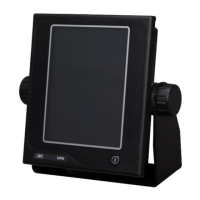Appendix-18
hours, to local time to obtain UTC. Local zone is generally negative for East longitudes with local exceptions near the
international date line.
Example: At Chatham Is. (New Zealand) at 1230 (noon) local time on June 10, 1995:
$GPZDA,234500,09,06,1995,-12,45*6C<CR><LF>
In the Cook Islands at 1500 local time on June 10, 1995:
$GPZDA,013000,11,06,1995,10,30*4A<CR><LF>
・GNS – GNSS fix data
$-- GNS, hhmmss.ss, llll.ll, a, yyyyy.yy, a, c--c,xx,x.x,x.x,x.x,x.x,x.x,a *hh<CR><LF>
1
2 3 4 5 6 7 8 9 10 11 12 13
1:UTC of position
2:Latitude, N/S
3:Latitude, N/S
4:Longitude, E/W
5:Longitude, E/W
6:Mode indicator (see Note 1)
7:Total number of satellites in use, 00-99
8:HDOP (see Note 3)
9:Antenna altitude, m, re: mean-sea-level (geoid)
10:Geoidal separation, m (see Note 4)
11:Age of differential data (see Note 2)
12:Differential reference station ID (see Note 2)
13:Navigational status indicator (see Note 5)
NOTE 1 Mode indicator. A variable length valid character field type with the first three characters currently defined.
The first character indicates the use of GPS satellites, the second character indicates the use of GLONASS
satellites and the third indicate the use of Galileo satellites. If another satellite system is added to the standard, the
mode indicator will be extended to four characters, new satellite systems should always be added on the right, so the
order of characters in the mode indicator is: GPS, GLONASS, Galileo, other satellite systems in the future. The
characters should take one of the following values:
A = Autonomous. Satellite system used in non-differential mode in position fix
D = Differential. Satellite system used in differential mode in position fix
N = No fix. Satellite system not used in position fix, or fix not valid
P = Precise. Satellite system used in precision mode. Precision mode is defined as: no deliberate degradation
(such as selective availability) and higher resolution code (P-code) is used to compute position fix. P is
also used for satellite system used in multi-frequency, SBAS or Precise Point Positioning (PPP) mode
S = Simulator mode
The mode indicator should not be a null field.
NOTE 2 Age of differential data and Differential Reference Station ID:
a) When the talker is GN and more than one of the satellite systems are used in differential mode, then
the “Age of differential data” and “Differential reference station ID” fields should be null. In this case,
the “Age of differential data” and “Differential reference station ID” fields should be provided in
following GNS sentences with talker IDs of GP, GL, etc. These following GNS messages should have
the latitude, N/S, longitude, E/W, altitude, geoidal separation, mode, and HDOP fields null. This
indicates to the listener that the field is supporting a previous $GNGNS sentence with the same time
tag. The “Number of satellites” field may be used in these following sentences to denote the number of
satellites used from that satellite system.
Example: A combined GPS/GLONASS receiver using only GPS differential corrections has the following
GNS sentence sent.
$GNGNS,122310.2,3722.425671,N,12258.856215,W ,DA,14,0.9,1005.543,6.5,5.2,23*59<CR><LF>
Example: A combined GPS/GLONASS receiver using both GPS differential corrections and GLONASS
differential corrections may have the following three GNS sentences sent in a group.
$GNGNS,122310.2,3722.425671,N,12258.856215,W ,DD,14,0.9,1005.543,6.5,,*74<CR><LF>
$GPGNS,122310.2, , , , , ,7, , , ,5.2,23*4D<CR><LF>
$GLGNS,122310.2, , , , , ,7, , , ,3.0,23*55<CR><LF>
The Differential Reference station ID may be the same or different for the different satellite systems.
b) Age of Differential Data
For GPS Differential Data:
This value is the average age of the most recent differential corrections in use. When only RTCM SC104
Type 1 corrections are used, the age is that of the most recent Type 1 correction. When RTCM SC104
Type 9 corrections are used solely, or in combination with Type 1 corrections, the age is the average of the
most recent corrections for the satellites used. Null field when Differential GPS is not used.
NOTE 3 HDOP calculated using all the satellites (GPS, GLONASS, Galileo and any future satellites) used in
computing the solution reported in each GNS sentence.
NOTE 4 Geoidal Separation: the difference between the earth ellipsoid surface and mean-sea-level (geoid) surface
defined by the reference datum used in the position solution, “-” = mean-sea-level surface below ellipsoid. The
reference datum may be specified in the DTM sentence.

